An amputee’s toughest challenge yet: a 140-mile run in the desert
How one woman overcame a bloody journey in relentless heat over sand dunes, dry valleys and stony plateaus
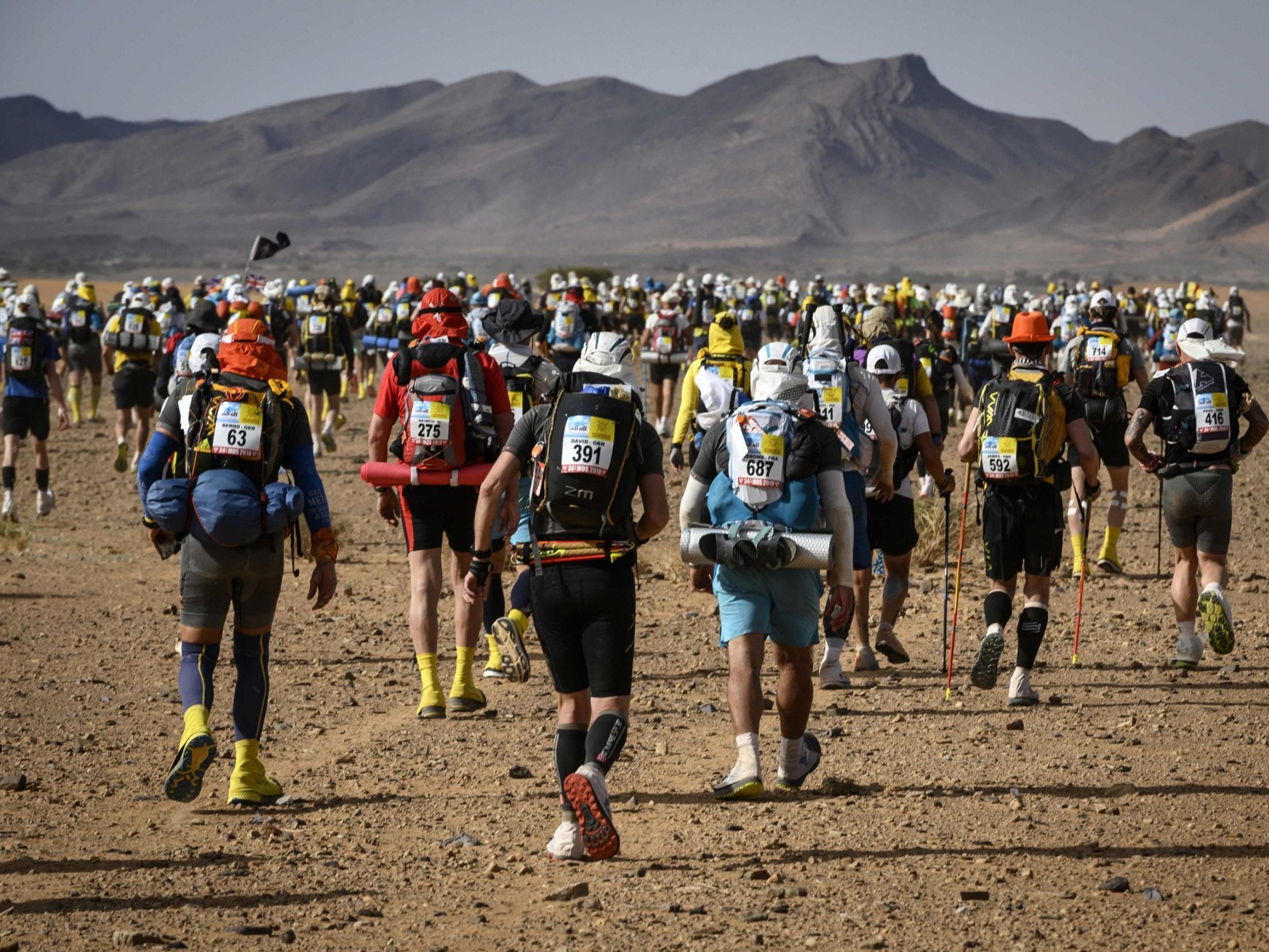
Your support helps us to tell the story
From reproductive rights to climate change to Big Tech, The Independent is on the ground when the story is developing. Whether it's investigating the financials of Elon Musk's pro-Trump PAC or producing our latest documentary, 'The A Word', which shines a light on the American women fighting for reproductive rights, we know how important it is to parse out the facts from the messaging.
At such a critical moment in US history, we need reporters on the ground. Your donation allows us to keep sending journalists to speak to both sides of the story.
The Independent is trusted by Americans across the entire political spectrum. And unlike many other quality news outlets, we choose not to lock Americans out of our reporting and analysis with paywalls. We believe quality journalism should be available to everyone, paid for by those who can afford it.
Your support makes all the difference.It was the last difficult stage of one of the world’s most punishing races. The runners, by now walking, began a steep climb up a 25 per cent gradient, which required many of them to use fixed ropes to reach the summit. As Amy Palmiero-Winters, 46, of Hicksville, New York, began the sharp ascent, her prosthetic left leg became stuck beneath a rocky outcropping.
Each time she tried to lift the carbon fibre leg, her shoe bounced against the rock, unable to clear it. Finally, the runner behind her reached and pulled the leg backwards, and Palmiero-Winters swung her foot over. She was free to continue her attempt to become the first female amputee to complete the Marathon des Sables, a stage race roughly equivalent to running 23.5 miles a day for six days in relentless heat over sand dunes, rocks, dry valleys, stony plateaus and salt flats in southern Morocco.
About 780 runners (and one dog) from 51 nations fell into single file to make the abrupt ascent: a woman from Malaysia who ran the entire 140.7 miles of the ultramarathon in flip-flops; the dog, a nomad nicknamed Cactus, who ran in five of the stages and went viral on the internet; a jeweller from Dubai who once worked the American south, eating furtive meals at Waffle House counters with diamonds strapped to his chest.
Each runner carried a backpack containing everything needed for a week in the desert: food, sleeping bag, compass, headlamp, venom pump to minimise any bites from snakes and scorpions. Each had his or her own motivation: to reconsider a bad marriage; to kick a habit of sloth and cigarettes; to find a new challenge after rowing across the Arctic Ocean.
This was the first attempt at the Marathon des Sables for Palmiero-Winters or any female amputee in the 34 years of the race, organisers said.
Her lower left leg was amputated below the knee in 1997 after a motorcycle accident. She is a single mother of two teenagers, 15 and 13, and is intensely driven, remarkably persevering. She trained for the heat of the desert, in part, by doing lunges and burpees in a sauna. She also placed her fiancé’s two young boys on her shoulders while she ran during her CrossFit workouts, then put them on her back while she did bear crawls, to grow accustomed to the heaviness of a backpack.
Before this desert race, she had established a dozen or so world records or firsts for below-the-knee amputees, including running the 26.2 miles of the 2006 Chicago marathon in 3 hours 4 minutes 16 seconds. In 2009, she won the James E Sullivan Award as the nation’s top amateur athlete. In 2011, she became the first female amputee to finish the Badwater ultramarathon, a brutal 135-mile race in July from Death Valley to the Mount Whitney trailhead at 8,300ft.
Now she faced perhaps her harshest test, this marathon of the sand, taking tens of thousands of jarring strides on her prosthetic leg, her natural leg having borne years of asymmetrical pounding, the calf with reduced function, the foot with broken metal screws, the second toe fused straight. She wanted to complete this race to inspire, to show how not to succumb to artificial limits, she said. She wanted her children to understand about pushing the envelope and not selling themselves short.
“When it’s your last day, you want to come in skidding sideways, your body worn out,” she said, discussing her approach not only to running but to life.
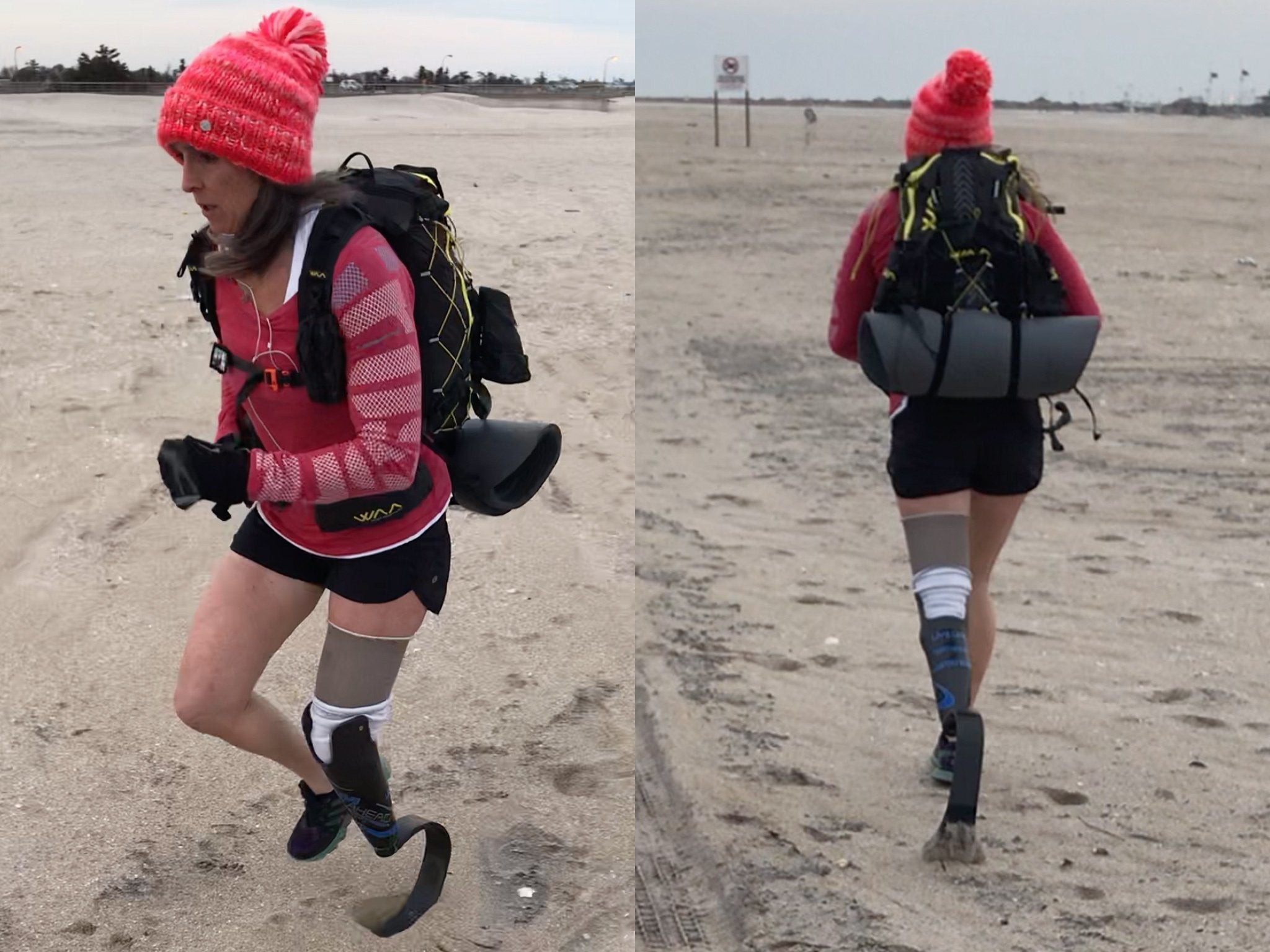
Palmiero-Winters did not spend much time studying the Marathon des Sables course. She did not want to know about terrain changes. She wore a watch, not to measure her pace or heart rate, but to remember what time it was back home on Long Island. Her approach was not to think, only to put her head down and run. But that was a risky strategy in the desert.
At 5ft 7ins and 120 pounds, she faced enormous challenges almost immediately and repeatedly — first her breathing, then with running on a carbon fibre leg in a forbidding environment while carrying a backpack that weighed 19 pounds. Her 13-year-old daughter, Madilynn, had seemed to acutely understand the risks. She gave her mother a note that was laminated and hung from the rucksack: “Good luck. I love you. Don’t die.”
Growing up in Meadville, Pennsylvania, Palmiero-Winters found freedom in running. She ran track and cross-country in high school. Sometimes she ran from her family’s drive-in to deliver orders of chicken wings to softball tournaments. Other times, she headed out to run after the drive-in closed at night, a family friend trailing in a Ford Ranger.
“Some people are born to do certain things,” said a family friend, Stacy Meyer. “She was born to run, I guess.”
Running, too, became a form of escape, Palmiero-Winters said, when she was raped in high school and when her father drank and physically and verbally abused her mother, or when her own brief marriage turned turbulent. Both her parents died this year. “Sports gave me self-confidence,” she said. “When something bad happened to me, I went out for a run. It kept me from any darkness.”
She attended Youngstown State university in Ohio, and planned to study criminal justice, join the military and become a police officer. But she said she dropped out of school when her family could no longer afford the cost. She became a carbide furnace operator at a plant in Meadville. Later, she became a welder.
Her life’s trajectory changed in April 1994, as she rode her Harley-Davidson 883 Sportster with friends. As Palmiero-Winters came up a hill in Meadville, a woman pulled from a stop sign and struck her, badly injuring her lower left leg. Doctors wanted to amputate immediately but she resisted. She was a runner. She could not imagine not running.
In 1995, she ran the Columbus Marathon in Ohio in 4:03:37 but felt pain in every step. She realised that a door was beginning to close. She was only putting off the inevitable. By then, she said, atrophy and surgery had reduced the size of her left foot to four and a half from seven and a half. Her left ankle also began to fuse. Finally, after more than two dozen surgeries, her left leg was amputated below the knee in July 1997.
Palmiero-Winters tried to run again when she received a prosthesis, but it was not built for sports. If she ran three miles, she needed three days to recover. At one point, she threw out all of her running gear. That was it, she thought. Then she reconsidered. Running defined her. In October 2005, with a somewhat better prosthetic, she won her division of athletes with disabilities at the world triathlon championships in Hawaii. She wanted to begin running races of 100 miles or more, but her running leg was low-tech, its foot made of wood and foam.
A fellow competitor told her about A Step Ahead Prosthetics in Hicksville, and she drove there with her mother and her two children. Erik Schaffer, the company’s founder and chief executive, called the prosthetic leg Palmiero-Winters arrived wearing, “the meat grinder,” which left her with bruising and contusions on her residual leg and was effectively like trying to run in a ski boot.
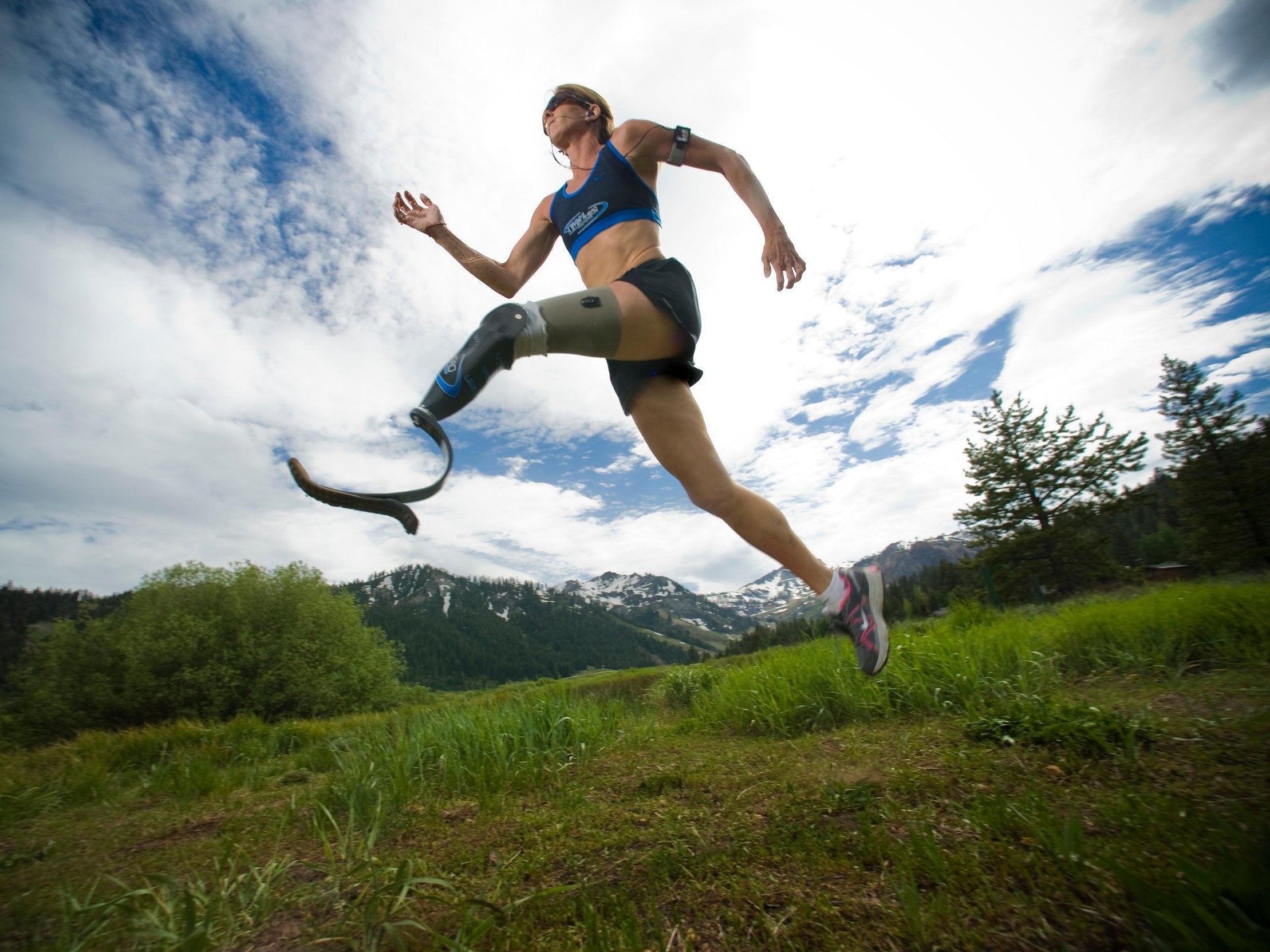
He began to make custom running legs for her, and in 2010, Palmiero-Winters became the first amputee to be named in a US national track team in a championship event. She competed in the 24-Hour World Championships, helping the Americans finish fourth. “Amy is kind of like a mudder,” Schaffer said. “The worse the conditions, the better the Amy.” She is now the company’s director of operations.
Palmiero-Winters took three to five prosthetic legs with her to many ultra-races to adapt to variable terrain and was sometimes aided by a crew from A Step Ahead. But support crews are not allowed at the Marathon des Sables, and she brought only one extra prosthesis for walking when she was not racing.
On the bottom of her running blade in the Sahara, Palmiero-Winters wore a scrap of Goodyear tyre, 3.5ins wide, for traction. The prosthesis included an air chamber to cool its outer and inner layers. Then the leg was coated in a chalky colour with paint used on the roofs of houses and buildings in the desert. It was critical to keep sand from getting between Palmiero-Winters’ skin and the silicon liner of her prosthesis, said Schaffer, who fashioned the prosthetic leg. The rubbing would mercilessly abrade her skin, he said, not unlike trying to run a marathon in a bathing suit full of sand.
“If Amy was out there and she needed to sit down and took off her liner and it hits the sand, it’s absolutely game over,” Schaffer said.
The Marathon des Sables began on 7 April, the morning still cool, hills pink and brown on the horizon, the sand and rock the tawny colour of lions. With loudspeakers blasting AC/DC’s “Highway to Hell”, Palmiero-Winters and the rest of the field took off for a 20-mile stage. She wore what most wore for shade, a hat with flaps over the ears and neck, which gave the runners the look of extremely fit beagles.
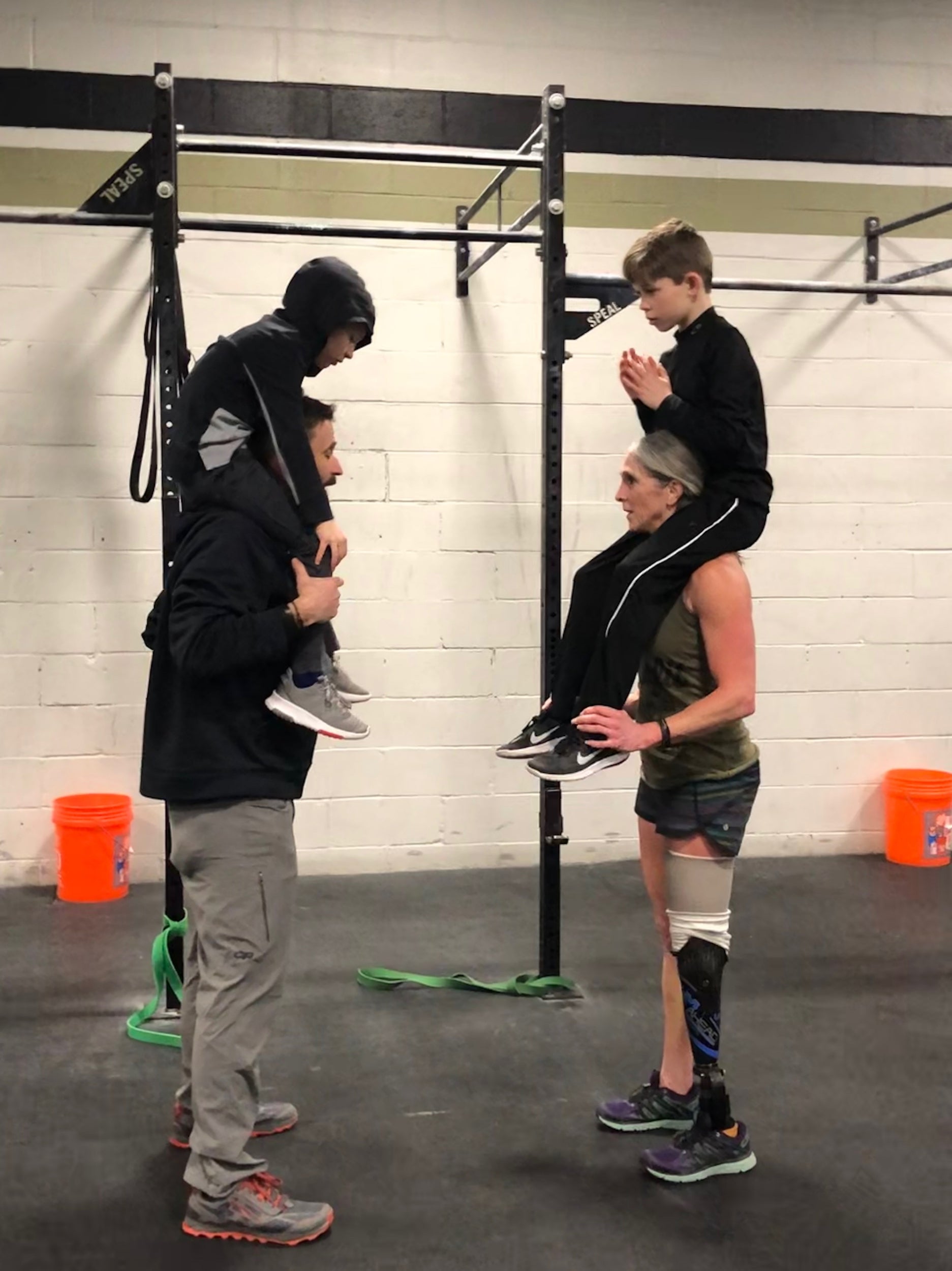
Palmiero-Winters stored a dental floss pick in the liner of her prosthetic leg to keep the nuts and fruit and seeds from her protein bars from getting stuck in her teeth. She also slipped an MP3 player inside the liner. She planned to listen to Eminem for the entire race, drawn to the rapper’s me-against-the-world bravado.
“Nobody believed in him; he paved his own path,” Palmiero-Winters said. “Same with me.”
Her first choice was a Dr. Dre song featuring Eminem called “I Need a Doctor”. It was not meant to be a literal request. But only about 5.5 miles into the race, as Palmiero-Winters crested a short, steep hill, her lips appeared to bulge, as if with a plug of tobacco. She feared she was going into anaphylactic shock from an unknown allergy. Her tongue seemed thick, her words heavy.
“It’s shutting down my airway,” she said. “My throat is closing.”
She had an epinephrine injector to treat the attack but hesitated to use it. The Marathon des Sables allows only limited assistance to runners. Palmiero-Winters feared that if she used the EpiPen now and her shortness of breath returned during another stage, she might be forced to leave the race.
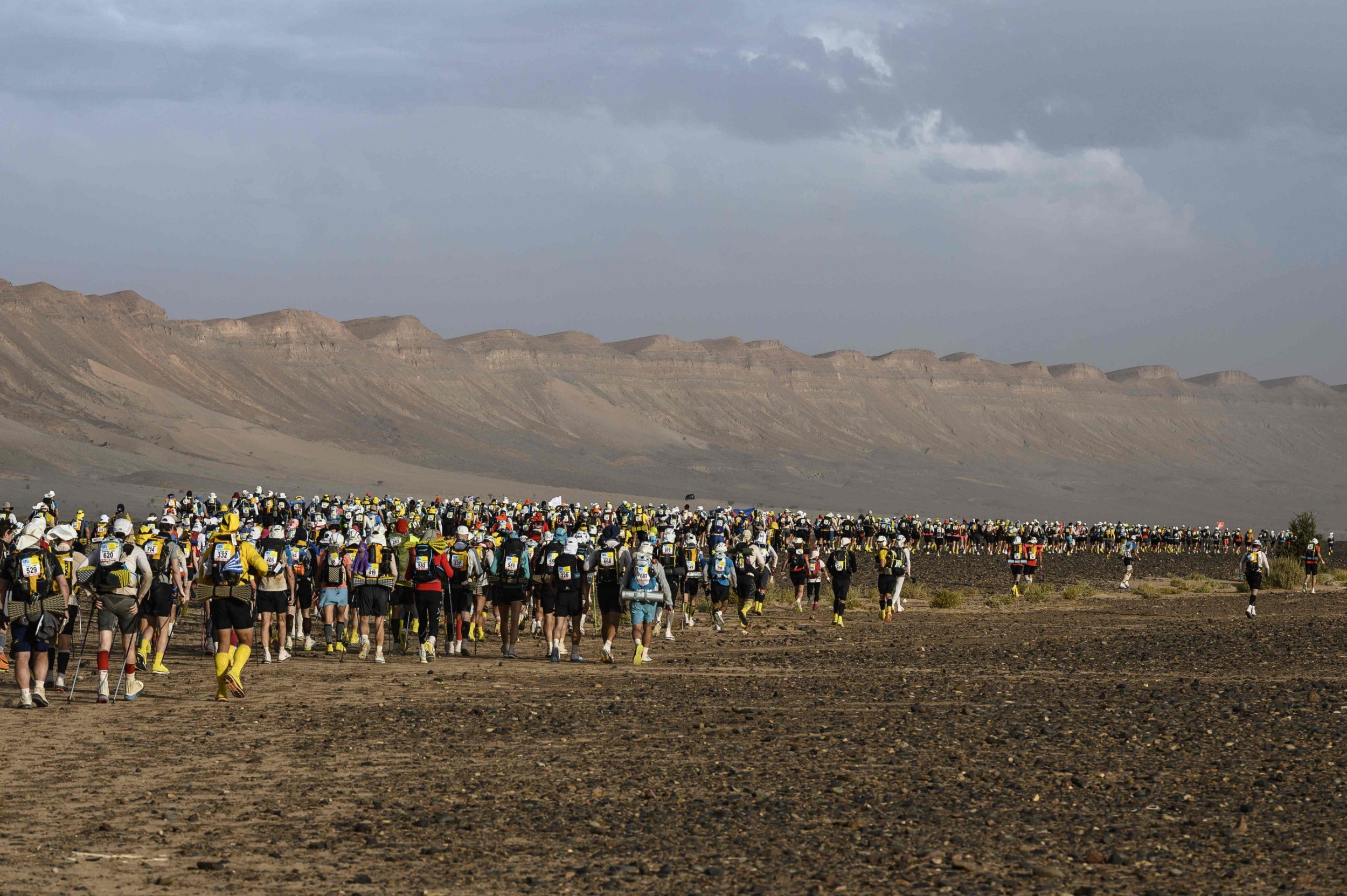
Fortunately for her, her airways soon opened without an injection and her breathing problem did not return. The next day featured a 20.2-mile stage, including perhaps the most difficult section of the race – eight miles traversing some of the biggest dunes in Morocco, known as the Erg Chebbi. The unremitting ups and downs were the cumulative equivalent of climbing a 115-storey building.
The sun was relentless. The wind picked up and sand blew into eyes and noses. Some runners sought relief from the heat under bushes in the dunes. A former British paratrooper crawled over some dunes to navigate the loose sand. A Frenchwoman fell out, exhausted, as she cleared the dune field.
Palmiero-Winters had hoped to run the entire race. But that was impossible in this terrain. So she improvised and switched from her running prosthetic to her walking prosthetic. The running leg, a blade, kept her on her tiptoes; the walking leg was attached to a running shoe and had a heel. It would give her more surface area to plant into the sand and, she hoped, a shallower step. But even before the dunes, sand began to pour into the running shoe and the prosthetic foot. She had no sand gaiter for that prosthetic and tried, without success, to cover the opening between the carbon fibre leg and the shoe with a plastic bag. As the dunes approached, she grew discouraged.
“I feel like such a failure,” she said.
All runners feel emotional swings during long races. And while Palmiero-Winters struggled in the dunes, she also drew strength by considering her life’s impediments and how she had overcome them.
Through the dune stage, she used trekking poles and followed another runner who veered from the well-trod path, seeking spots of untrammelled, crusty sand. This more secure footing required less energy to plant and withdraw her shoe. She also looked for tracks where passing camels had made only slight indentions.
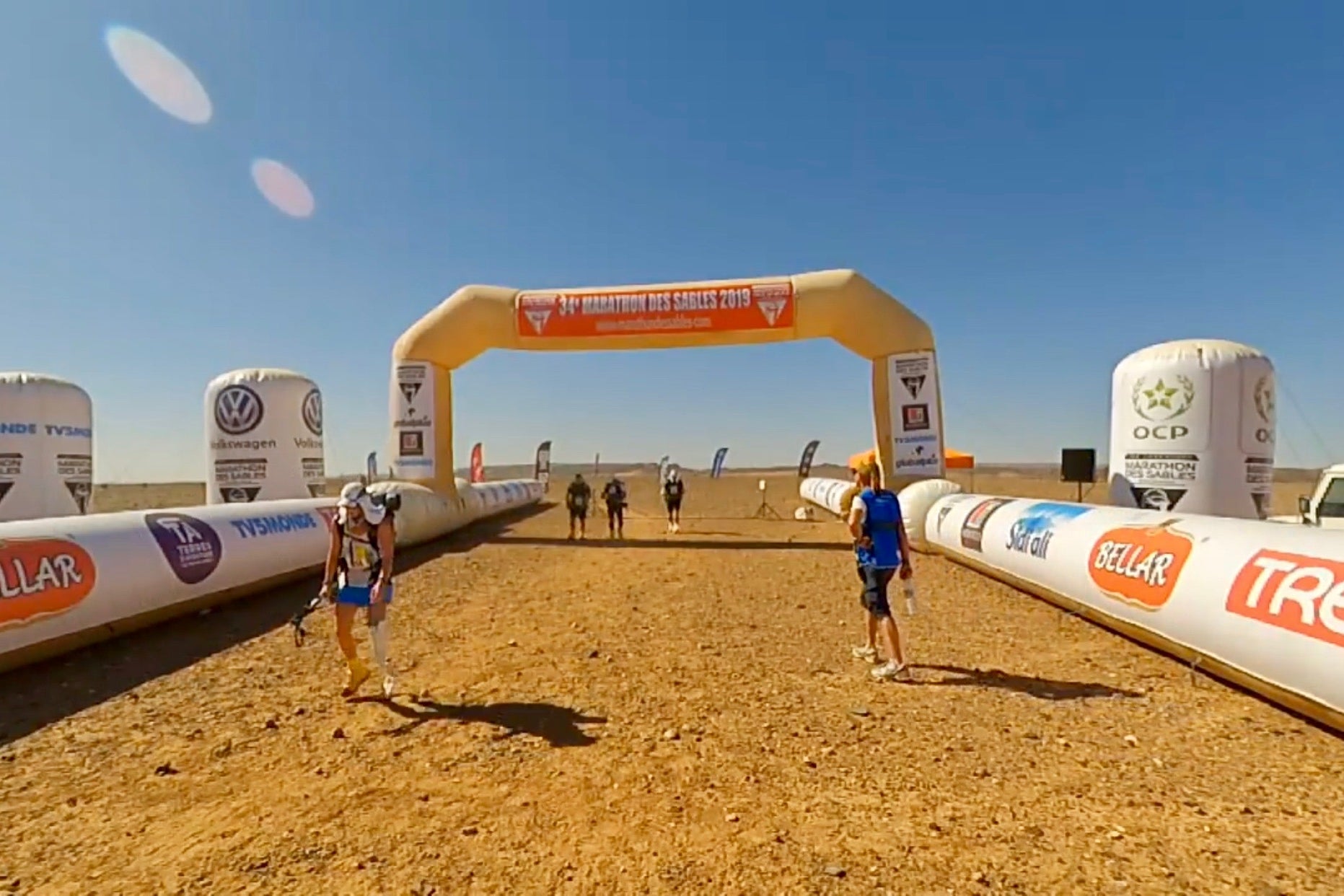
After nearly three hours, Palmiero-Winters emerged from the dunes and consoled a British woman who was on her back with blistered feet. “I want to cry, too,” Palmiero-Winters said, “but you’ve got this, kiddo. Take deep breaths, one foot in front of the other.”
At the finish line, she returned to the tent she shared nightly with six other runners and did 100 push-ups.
For the third stage, a 23.1-miler, Palmiero-Winters started with the running blade but found it impossible to lengthen her stride in the sand and on rocky plateaus. Her body was taking a tremendous pounding. A prosthesis cannot soften the landing on different surfaces the way a natural leg can by flexing at the knee and ankle to maintain a certain amount of “give” as the foot strikes the ground.
With each choppy stride, the weight of Palmiero-Winters’ backpack jolted the back and side of her left knee. Skin began to peel inside the liner of her prosthesis. Three toenails on her right foot began to loosen. The sun was ruthless and the thermometer on her prosthetic leg reached 50C. A former US marine, an amputee who had completed the 2018 Marathon des Sables, had to withdraw as his residual leg began to swell uncomfortably.
Palmiero-Winters told herself, “I don’t know if I can do this.”
When she removed the prosthesis after the stage, one of her tent mates asked, “Is that iodine?”
“No,” Palmiero-Winters said. “That’s blood.”
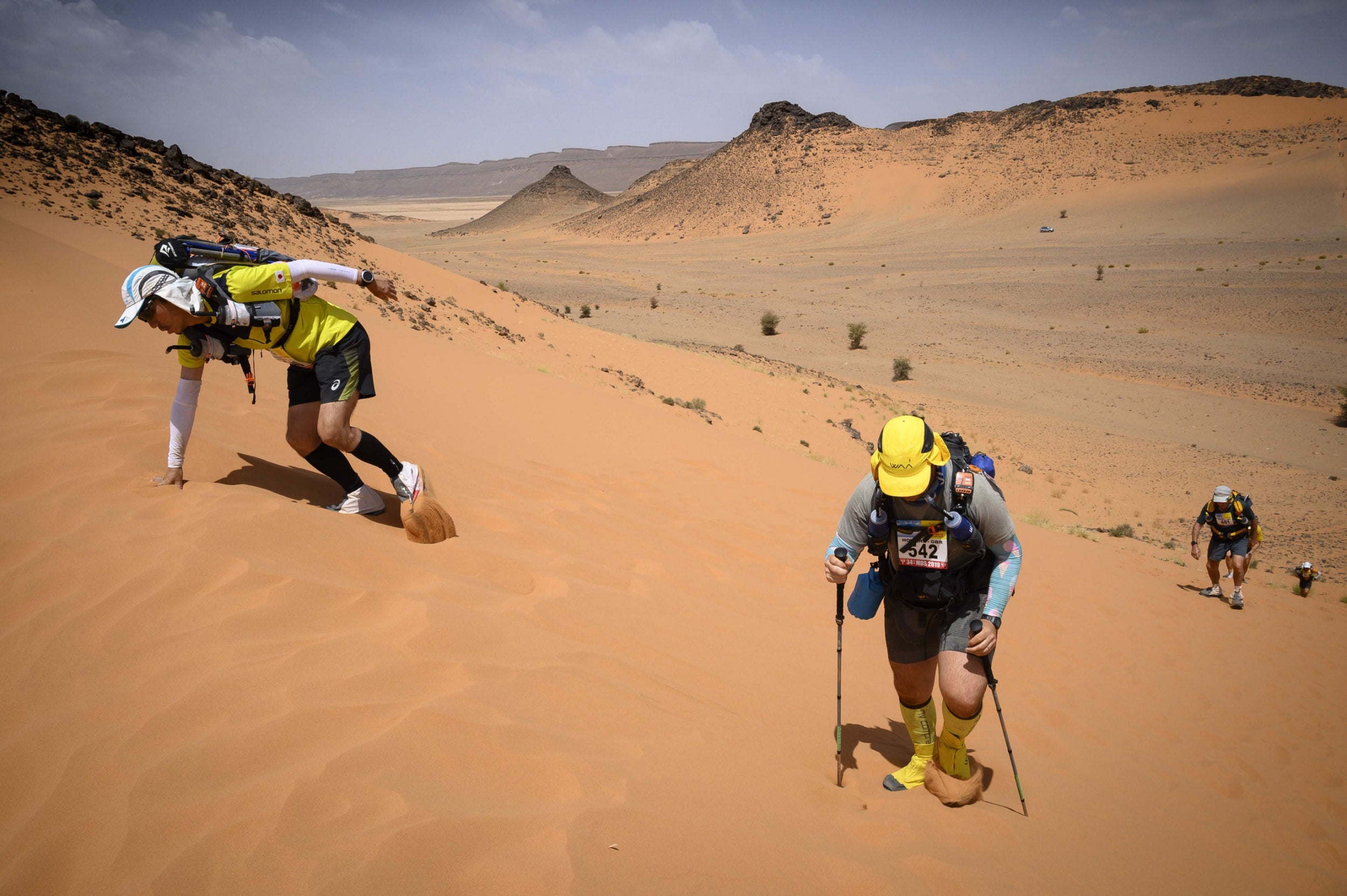
She went to the medical tent and returned with disinfectant and a bandage. It was clear that her residual leg would hurt with each stride the rest of the way. So she would keep taking one step, then the next, and repeating to herself Dory’s line in Finding Nemo: “Just keep swimming.”
The longest stage, 47.4 miles, with a 31-hour time limit, began with cloud cover and cooler temperatures. In a small village, Palmiero-Winters slapped hands with schoolchildren as women nearby baked bread in an earthen oven. But the sun burned through as runners passed near a butte that resembled a tagine and a cemetery mound for a nomad family with makeshift gravestones at the head and feet. After days without showering, runners were caked in grime. Food supplies were running low in backpacks.
“I’d pay $1,000 for a pepperoni pizza,” said Moritz Baier-Lentz, a German runner who works at Goldman Sachs in New York. At checkpoints, runners took bottles of water and salt tablets, which Chuck Allison of Milwaukee called “desert candy”.
“My body is telling me to stop,” he said, “but my brain is saying, ‘Shut your filthy mouth.’”
The rocks kept bouncing Palmiero-Winters around. She fell on her right knee. An m-shaped scab formed. At a checkpoint after 13 miles, she wiped away tears. Still, she planned to keep running through the night. The thermometer on her running leg reached 62C in the afternoon. A sandstorm kicked up before dusk. Some runners and vehicles came to a brief halt. Officials at one checkpoint put on ski goggles. But Palmiero-Winters remained behind the storm and began to pick up speed in a flat valley at night, wearing a headlamp and a glow stick on her backpack.
Her vision was restricted to the circle of light shown by her headlamp, though, and Palmiero-Winters kept tripping over rocks. At a checkpoint after 31.5 miles, a nurse gave her a painkiller, her first. She switched to her walking leg, which had been ferried in an SUV. She taped up the front of her shoe and sealed the gap where the prosthetic leg inserted into the sneaker with a rubber foot.
Just before dawn, after 20 hours 25 minutes, Palmiero-Winters reached the finish. A tent mate, Simran Singh, an Apple engineer from San Francisco, high-fived her in his sleep.
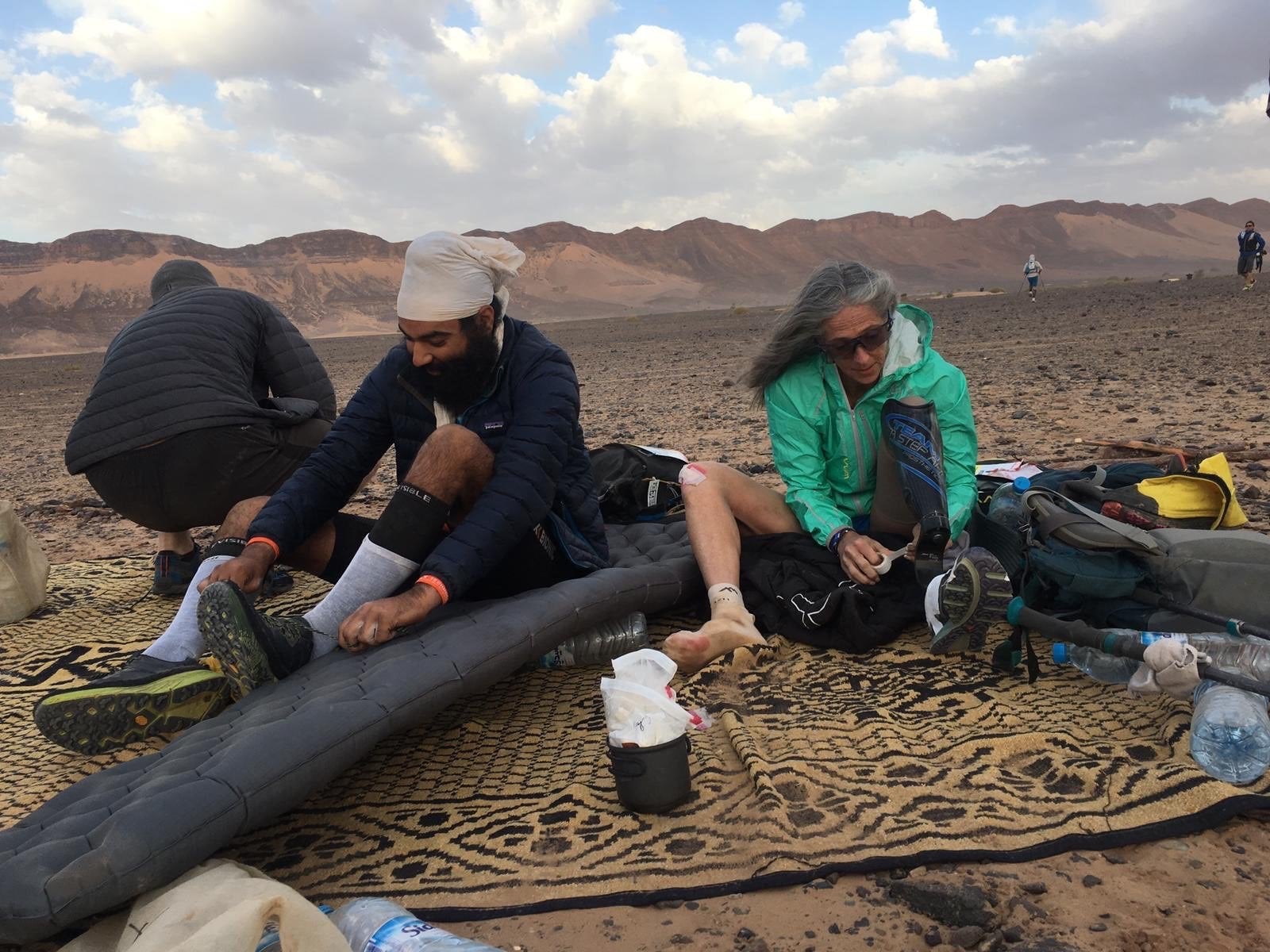
“She changed my definition of sanity and strength,” said Singh, who entered the race to overcome panic attacks. “You think she won’t make it, but she does.”
After a day of rest, the runners embarked on a standard marathon stage of 26.2 miles that began with the steepest climb of the week, a 25 per cent grade that forced some of the runners to use fixed ropes. The runners passed a man digging furiously with a shovel. He spotted an iguana and scooped it from its burrow. Later he would eat the lizard, its blood said to be a curative for spring allergies.
Palmiero-Winters wore her walking prosthesis but, by the first checkpoint, she had developed a significant limp. Her residual leg was hot and striped red with blisters and peeled skin.
“It hurts so much,” she said. “I wish I could run. God, I wish I could run.”
By the second checkpoint, where pink flowers had been scattered across the path in a narrow gorge, she was bent over in pain. But as in previous days, she recovered as the stage progressed. Near the finish line, she broke into a trot, smiling and high-fiving a small crowd that gathered. Patrick Bauer, the race director, placed a medal around Palmiero-Winters’ neck and hugged her. All that remained was an untimed 3.8-mile run for charity the next morning. Of the 780 runners who started, all but 40 would finish the race.
She limped to the medical tent and was examined by an orthopaedic surgeon who applied antiseptic cream and bandages to Palmiero-Winters’ residual leg. No bones or tendons were exposed, the surgeon said. The wounds were superficial but needed monitoring.
As Palmiero-Winters returned to her tent, applause broke out. Competitors bumped fists with her. They told her she was a “total badass”. She laughed about a fall she took about a half-mile from the finish, when her leg seemed to whip over her head like a scorpion’s tail.
“When I fall, I laugh, I cry, I get back up,” she said, “and I keep going.’’
Join our commenting forum
Join thought-provoking conversations, follow other Independent readers and see their replies
Comments